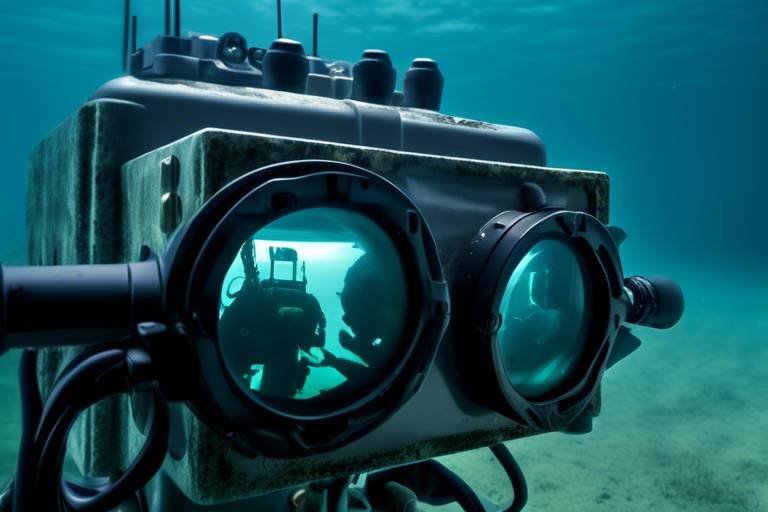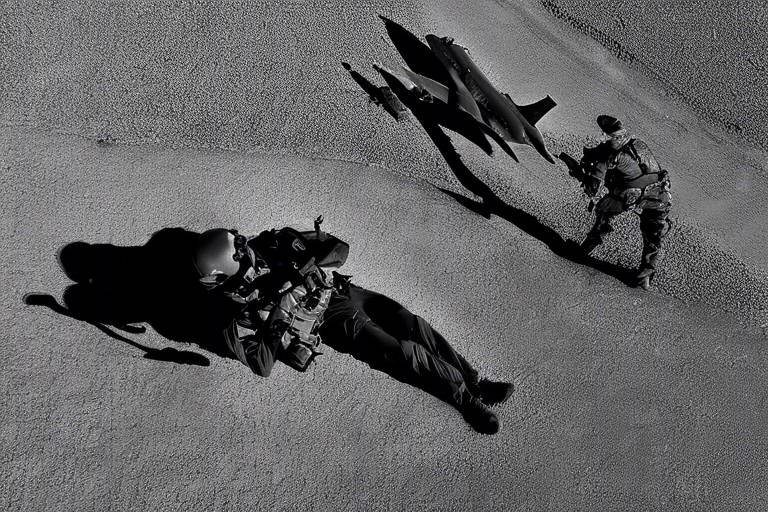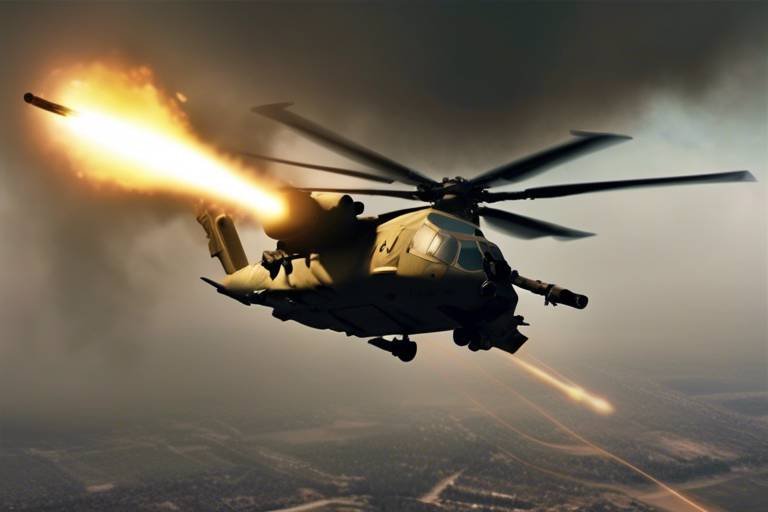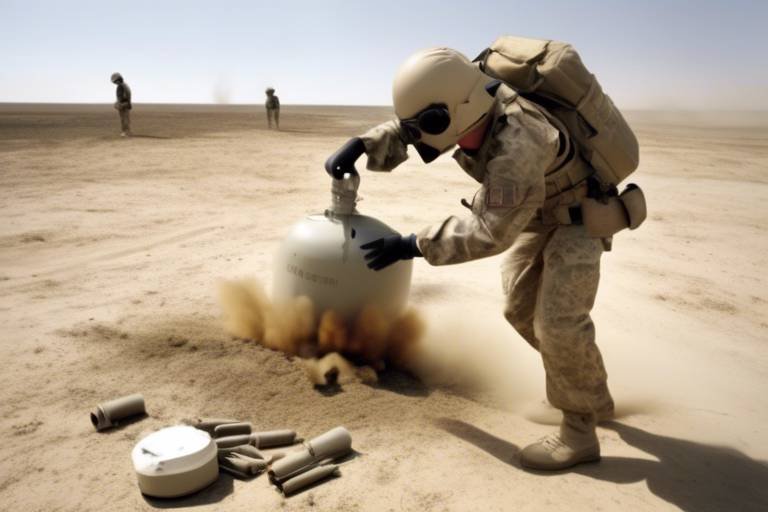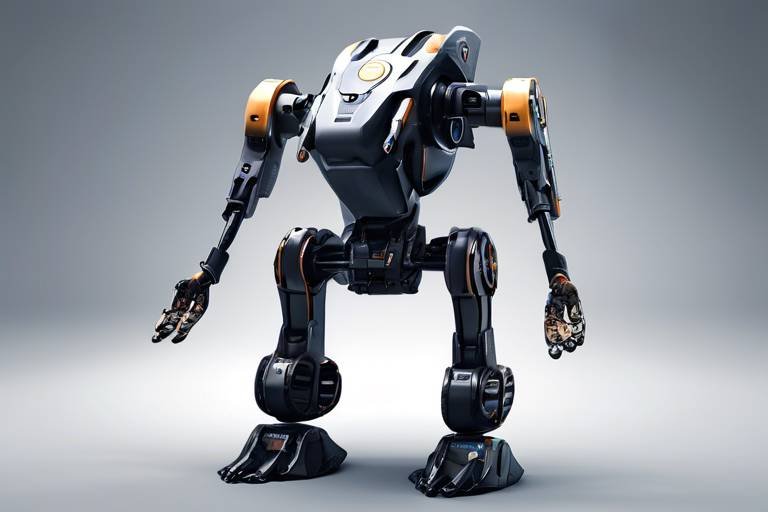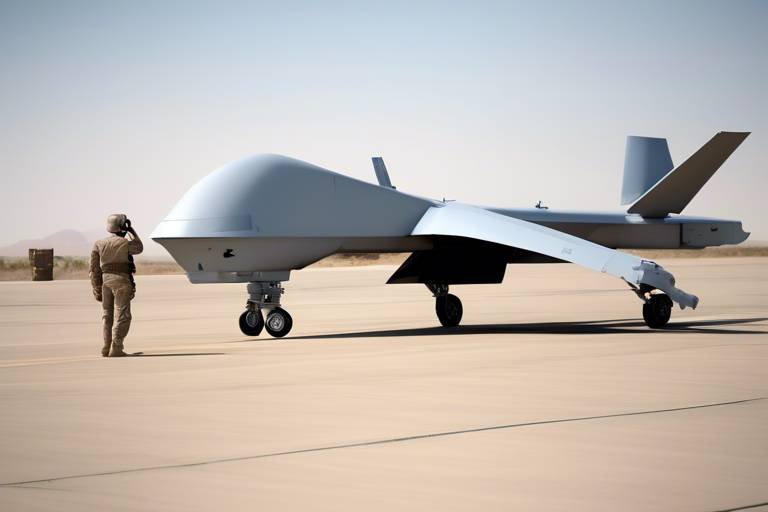The Role of the ROVs in Underwater Military Surveillance
In the ever-evolving landscape of military operations, remotely operated vehicles (ROVs) have emerged as a game-changer in underwater surveillance. Imagine a sleek, high-tech machine gliding silently through the depths of the ocean, gathering crucial intelligence without putting human lives at risk. This is not a scene from a sci-fi movie; it’s the reality of modern warfare. ROVs are equipped with cutting-edge technology that allows them to perform a variety of functions, from reconnaissance to data collection, all while operating in environments that are often too dangerous for personnel.
The significance of ROVs in military operations cannot be overstated. These vehicles are designed to withstand the harsh conditions of underwater environments, making them invaluable for missions ranging from coastal surveillance to mine detection. Furthermore, their ability to operate remotely means that military personnel can stay safe while still gathering vital information. As we delve deeper into the capabilities and applications of ROVs, it becomes clear how they have transformed military underwater surveillance into a more effective and efficient process.
To truly appreciate the role of ROVs in military underwater surveillance, it’s essential to understand the technology behind them. ROVs are typically designed with a combination of rugged materials and advanced engineering, allowing them to navigate through challenging underwater terrains. They come in various shapes and sizes, tailored for specific missions. For instance, some ROVs are small and agile, perfect for tight spaces, while others are larger and equipped with heavier payloads for extensive data collection.
Most ROVs are equipped with a suite of sensors and cameras that provide high-resolution imaging and real-time data transmission. This means that military command centers can receive live feeds from the ROV, allowing for immediate analysis and decision-making. The integration of artificial intelligence and machine learning into ROV systems is also on the rise, enhancing their ability to process information and adapt to changing environments.
The advantages of utilizing ROVs in military surveillance are profound. First and foremost, they significantly increase the safety of military personnel. By deploying ROVs for dangerous missions, the risk of human casualties is minimized. Additionally, ROVs are cost-effective solutions for gathering intelligence. They reduce the need for extensive manned missions, which can be both expensive and risky.
ROVs are equipped with high-resolution cameras and advanced sensors that vastly improve surveillance capabilities. These devices can capture detailed images and gather data in real-time, which is crucial for effective reconnaissance missions. Imagine being able to monitor enemy movements or inspect underwater infrastructures without ever being detected. This level of surveillance is not just advantageous; it’s transformative.
The ability of ROVs to transmit data in real-time is another significant benefit. Information gathered by ROVs can be sent instantly to command centers, allowing military leaders to make informed decisions on the fly. This capability is particularly important during time-sensitive operations, where every second counts. The integration of secure communication channels ensures that sensitive information remains protected while being transmitted.
Stealth is a critical component of military operations, and ROVs excel in this area. These vehicles can operate quietly and discreetly, minimizing the risk of detection by adversaries. Their ability to navigate underwater without creating significant disturbances allows military forces to conduct operations in sensitive areas without alarming the enemy. This stealth capability enhances the overall success rates of missions, providing a strategic advantage.
ROVs do not operate in isolation; they are often integrated with other military technologies, such as autonomous underwater vehicles (AUVs) and drones. This integration creates a comprehensive surveillance network, enhancing operational effectiveness. For example, while an ROV gathers data from the seabed, an AUV can be deployed to cover a larger area, providing a multi-layered approach to surveillance.
Despite their numerous advantages, ROVs face several challenges in military applications. Technical limitations, environmental factors, and the need for skilled operators can hinder their effectiveness. Understanding these challenges is crucial for improving ROV technology and ensuring successful mission execution.
ROVs often encounter extreme temperatures, strong water currents, and visibility issues that can impact their performance. For instance, in deep-sea missions, the pressure can be immense, requiring ROVs to be built with specialized materials. Additionally, murky waters or strong currents can obstruct sensors and cameras, making data collection difficult.
While ROVs can be cost-effective in many ways, the initial deployment and ongoing maintenance can be expensive. Training skilled operators to manage these sophisticated machines is essential, and this requires significant investment. Furthermore, technology upgrades are necessary to keep pace with advancements in military operations.
The future of ROV technology looks promising, with emerging trends indicating a shift towards greater automation and enhanced capabilities. Advancements in artificial intelligence and machine learning will likely lead to ROVs that can make autonomous decisions, further reducing the need for human intervention. As technology continues to evolve, we can expect ROVs to play an even more critical role in underwater military surveillance.
- What are ROVs used for in military operations?
ROVs are primarily used for underwater surveillance, reconnaissance, mine detection, and data collection, providing critical intelligence without risking human lives. - How do ROVs transmit data?
ROVs utilize secure communication channels to transmit data in real-time to command centers, allowing for immediate analysis and decision-making. - What challenges do ROVs face?
ROVs encounter environmental limitations, technical challenges, and operational costs that can impact their effectiveness in military applications.

Overview of ROV Technology
Remotely Operated Vehicles, commonly known as ROVs, are a marvel of modern engineering, designed specifically for underwater exploration and surveillance. These sophisticated machines are equipped with advanced technology that allows them to operate in the most challenging marine environments. Imagine sending a robot into the depths of the ocean, where humans cannot easily go, to gather crucial information about submerged landscapes, shipwrecks, or potential threats. That's the essence of what ROVs do!
At their core, ROVs consist of a hull that houses essential components such as cameras, lights, and sensors. The design is typically compact and robust, enabling them to withstand high pressures and turbulent waters. Most ROVs are tethered to a surface support vessel via a cable, which provides power and allows for real-time data transmission. This tethering system is crucial as it ensures that the ROV remains connected to its operators, facilitating control and communication throughout the mission.
There are various types of ROVs, each tailored for specific tasks in military applications. Some are designed for surveillance, equipped with high-resolution cameras and sonar systems to capture detailed images and data from the underwater environment. Others may be built for recovery operations, featuring manipulative arms to retrieve objects from the seabed. The versatility of ROVs makes them an indispensable asset in military operations, whether for reconnaissance, mine detection, or even search and rescue missions.
Here’s a simplified overview of the different types of ROVs used in military operations:
| Type of ROV | Primary Function | Key Features |
|---|---|---|
| Observation ROV | Surveillance and reconnaissance | High-resolution cameras, sonar |
| Work-class ROV | Recovery and maintenance | Manipulative arms, tools |
| Micro ROV | Infiltration and intelligence gathering | Compact size, stealth capabilities |
The evolution of ROV technology has been remarkable, with advancements in materials, propulsion systems, and control algorithms enhancing their performance. For instance, the integration of artificial intelligence and machine learning is paving the way for ROVs that can operate autonomously, making them even more effective in gathering intelligence without constant human intervention. This shift not only improves efficiency but also reduces the risks associated with human operators working in hazardous conditions.
In summary, the role of ROVs in military underwater surveillance is growing increasingly vital. Their ability to operate in hostile environments, gather real-time data, and provide critical information to command centers makes them a cornerstone of modern military strategy. As technology continues to advance, we can expect ROVs to become even more capable, transforming how military operations are conducted beneath the waves.
- What is an ROV?
ROVs, or Remotely Operated Vehicles, are unmanned robots used for underwater exploration and surveillance. - How are ROVs operated?
They are typically operated from a surface vessel using a tether that provides both power and communication. - What types of missions can ROVs perform?
ROVs can perform a variety of missions, including surveillance, recovery operations, and environmental monitoring. - What advancements are being made in ROV technology?
Advancements include the integration of AI and machine learning, allowing for autonomous operations and improved data collection.

Benefits of ROVs in Military Operations
Remotely Operated Vehicles (ROVs) have revolutionized the way military operations are conducted underwater. By leveraging cutting-edge technology, these vehicles provide a multitude of benefits that enhance operational effectiveness and safety. One of the most significant advantages of ROVs is the increased safety they offer for personnel. Traditionally, underwater missions required divers to enter potentially hazardous environments, exposing them to various risks such as hostile marine life, extreme pressure, and unpredictable currents. With ROVs, military forces can conduct surveillance and reconnaissance without putting human lives in jeopardy, allowing for a safer approach to underwater exploration.
Moreover, the cost-effectiveness of ROVs cannot be overlooked. While the initial investment in ROV technology may be substantial, the long-term savings are significant. Deploying ROVs reduces the need for extensive diving teams and the associated training costs, as well as minimizing the potential for accidents that could lead to costly recovery operations. This financial efficiency is particularly crucial in a military context where budgets are often tight and every dollar counts.
ROVs also excel in gathering real-time intelligence in challenging underwater environments. Equipped with high-resolution cameras and advanced sensors, these vehicles can capture detailed images and data that are vital for mission success. For instance, ROVs can survey enemy installations, monitor naval activities, and inspect underwater infrastructures such as pipelines and cables without the need for physical presence. This capability is not only beneficial for reconnaissance missions but also for ensuring the safety and security of vital maritime assets.
When it comes to surveillance, ROVs provide enhanced capabilities that are unmatched by traditional methods. The integration of high-resolution imaging systems and sophisticated sensors enables ROVs to collect data that is critical for making informed decisions. For example, the ability to capture detailed underwater images helps military analysts identify potential threats and assess the condition of underwater structures. This is especially important in areas where visibility is low, as ROVs can operate in conditions that would be challenging or impossible for human divers.
Another significant advantage of ROVs is their ability to transmit data in real-time. This feature is essential for military operations, as it allows command centers to receive critical information instantaneously. Imagine a scenario where an ROV is deployed to monitor a suspicious underwater object. As the ROV captures images and data, this information is relayed back to the command center, enabling decision-makers to assess the situation and respond swiftly. This capability is akin to having a pair of eyes in the depths of the ocean, providing insights that can be the difference between mission success and failure.
In the realm of military operations, stealth is of utmost importance. ROVs are designed to operate discreetly, minimizing the risk of detection by adversaries. Their low profiles and quiet operation allow them to conduct surveillance missions without drawing attention. This stealth feature is particularly valuable in sensitive areas where the element of surprise can significantly impact the outcome of an operation. By utilizing ROVs, military forces can gather intelligence while remaining undetected, enhancing the chances of mission success.
In summary, the benefits of ROVs in military operations are profound and multifaceted. From ensuring the safety of personnel to providing real-time intelligence and enhancing surveillance capabilities, ROVs have become indispensable tools in modern warfare. As technology continues to advance, the potential for ROVs to transform military operations further is immense.
- What are ROVs used for in military operations?
ROVs are primarily used for underwater surveillance, reconnaissance, and inspection of maritime infrastructure, allowing military forces to gather intelligence without risking personnel. - How do ROVs transmit data?
ROVs are equipped with advanced communication systems that enable them to transmit real-time data and images back to command centers for immediate analysis and decision-making. - Are ROVs safe to operate?
Yes, ROVs significantly increase safety by eliminating the need for human divers in hazardous environments, thus reducing the risk of accidents and injuries.

Enhanced Surveillance Capabilities
When it comes to military operations, surveillance is the name of the game. In the murky depths of the ocean, where visibility is often a challenge, remotely operated vehicles (ROVs) shine like beacons of hope. These technological marvels are equipped with state-of-the-art features that enhance their ability to collect crucial data. Imagine having eyes that can penetrate the darkest waters, capturing high-resolution images and videos that provide a clear picture of the underwater landscape. This capability is not just impressive; it's essential for ensuring mission success.
ROVs are outfitted with advanced sensors that can detect a variety of environmental factors, including temperature, pressure, and even chemical compositions in the water. These sensors allow military personnel to gather real-time intelligence, offering insights that were previously unattainable. For instance, imagine an ROV deployed to monitor a potential hostile area. With its sophisticated imaging systems, it can relay live footage back to command centers, allowing decision-makers to assess situations dynamically and make informed choices on the fly.
Moreover, the surveillance capabilities of ROVs extend beyond mere imaging. They can be equipped with sonar technology that maps the ocean floor, identifying underwater structures, obstacles, and even potential threats. This data is invaluable, especially in reconnaissance missions where understanding the terrain can mean the difference between success and failure. The table below illustrates some of the key features of ROVs that contribute to their enhanced surveillance capabilities:
| Feature | Description |
|---|---|
| High-Resolution Cameras | Capture detailed images and videos for reconnaissance. |
| Advanced Sonar Systems | Map underwater terrains and detect objects. |
| Multi-Spectral Sensors | Analyze various environmental parameters. |
| Data Relay Systems | Transmit real-time information back to command centers. |
But it's not just about gathering data; it's about how that data is used. With the integration of machine learning algorithms, ROVs can analyze the information they collect on the go, identifying patterns and anomalies that human operators might miss. This level of intelligence transforms ROVs from simple tools into powerful assets in military operations. They can assist in identifying enemy vessels, monitoring maritime borders, and even conducting search-and-rescue missions in hostile environments.
In conclusion, the enhanced surveillance capabilities of ROVs are a game-changer in military underwater operations. They provide a level of insight and situational awareness that is unmatched, allowing for proactive measures rather than reactive responses. As technology continues to evolve, we can only expect these capabilities to improve, further solidifying ROVs as essential components in modern warfare.
- What are ROVs used for in military operations?
ROVs are primarily used for reconnaissance, surveillance, and data collection in underwater environments, providing real-time intelligence to military personnel. - How do ROVs transmit data?
ROVs use advanced data relay systems to transmit real-time information back to command centers, enabling timely decision-making. - What advantages do ROVs have over manned submarines?
ROVs offer increased safety for personnel, reduced operational costs, and the ability to operate in challenging environments without risking human lives. - Can ROVs operate in harsh underwater conditions?
Yes, ROVs are designed to withstand extreme temperatures, water currents, and visibility issues, making them suitable for a variety of underwater missions.

Real-time Data Transmission
In the fast-paced world of military operations, the ability to gather and relay information in real-time can mean the difference between success and failure. This is where remotely operated vehicles (ROVs) shine, as their real-time data transmission capabilities are crucial for effective decision-making. Imagine a scenario where a military unit is navigating treacherous underwater terrain; having instant access to data from an ROV can provide a tactical advantage that enhances situational awareness and operational effectiveness.
ROVs are equipped with advanced communication systems that allow them to transmit data back to command centers almost instantaneously. This capability is vital for several reasons:
- Immediate Insights: Commanders receive crucial information about enemy movements, environmental conditions, and other variables that can influence mission outcomes.
- Enhanced Coordination: With real-time data, different units can coordinate their actions more effectively, ensuring a synchronized approach to complex missions.
- Timely Adjustments: If conditions change unexpectedly, the data from ROVs allows for rapid reassessment of strategies, enabling teams to adapt on the fly.
Moreover, the technology behind real-time data transmission in ROVs often incorporates high-bandwidth communication links, which can handle large volumes of data, including high-resolution images and video feeds. This means that operators can not only see what the ROV sees but also analyze it in detail. The integration of advanced sensors, such as sonar and thermal imaging, further enhances the quality of the data collected, providing a comprehensive view of the underwater environment.
One of the most exciting developments in this area is the use of satellite communication systems and 5G technology, which promise to revolutionize how data is transmitted from ROVs. These technologies enable faster and more reliable communication, even in remote locations, which is particularly beneficial for military operations that may occur far from established infrastructure.
In summary, real-time data transmission is a game-changer in military underwater surveillance. It not only enhances the effectiveness of ROVs but also significantly improves the overall operational capabilities of military forces. As technology continues to evolve, we can expect even greater advancements in how ROVs communicate, ultimately leading to more successful missions and improved safety for personnel involved in underwater operations.
- What are ROVs used for in military operations? ROVs are primarily used for surveillance, reconnaissance, and intelligence gathering in underwater environments.
- How do ROVs transmit data in real-time? ROVs use advanced communication systems, including satellite links and high-bandwidth connections, to relay data back to command centers almost instantaneously.
- What advantages do ROVs provide over manned submarines? ROVs enhance safety by reducing the risk to personnel, are often more cost-effective, and can operate in conditions that may be too dangerous for manned missions.

Stealth and Discretion
When it comes to military operations, stealth and discretion are not just advantages; they are essential for success. Remotely Operated Vehicles (ROVs) are designed with these principles in mind, allowing military forces to conduct surveillance without drawing attention. Imagine a silent shadow gliding through the depths of the ocean, gathering critical intelligence while remaining undetected. That's the essence of what ROVs bring to the table.
One of the most significant features that enhance the stealth capabilities of ROVs is their low acoustic signature. Unlike traditional submarines or surface vessels, which can generate considerable noise, ROVs operate quietly, making it difficult for adversaries to locate them. This low noise profile is crucial when conducting sensitive operations in enemy waters, where even the slightest sound can betray their position.
Moreover, ROVs are often equipped with specially designed camouflage and stealth materials that minimize their visibility to both visual and electronic detection methods. This advanced technology enables them to blend seamlessly into their surroundings, whether they are navigating coral reefs or rocky seabeds. The ability to remain hidden allows military personnel to gather information without alerting enemy forces, thus increasing the chances of mission success.
The discretion offered by ROVs extends beyond just their physical design. These vehicles can be deployed from a distance, ensuring that operators remain safely on board a larger vessel or even on land. This remote operation capability means that personnel are less exposed to potential threats, significantly reducing the risk to human lives. With ROVs, military forces can gather vital intelligence without putting themselves in harm's way.
Additionally, ROVs can perform a variety of tasks that require a high level of precision and stealth. For instance, they can be used for underwater reconnaissance, mine detection, and even sabotage operations. Each of these tasks demands a level of discretion that traditional military methods may not provide. By utilizing ROVs, military units can execute missions that require a subtle touch, often yielding results that would be impossible through conventional means.
In summary, the stealth and discretion of ROVs are pivotal in modern military operations. They allow for covert surveillance, reduce risks to personnel, and enable complex missions to be carried out with minimal detection. As technology continues to advance, we can expect these vehicles to become even more adept at operating under the radar, ensuring that military forces maintain their strategic edge in underwater warfare.
- What are ROVs used for in military operations? ROVs are primarily used for underwater surveillance, reconnaissance, mine detection, and other covert operations.
- How do ROVs maintain stealth during missions? ROVs maintain stealth through low acoustic signatures, advanced camouflage, and remote operation capabilities.
- Are ROVs operated by humans? Yes, ROVs are remotely operated by trained personnel who control them from a safe distance.
- What advantages do ROVs offer over traditional submarines? ROVs offer enhanced stealth, reduced operational costs, and the ability to gather intelligence without risking human lives.

Integration with Other Technologies
In the ever-evolving landscape of military operations, the integration of Remotely Operated Vehicles (ROVs) with other advanced technologies has become a game-changer. Imagine a multi-layered defense system where ROVs, autonomous underwater vehicles (AUVs), and drones work in perfect harmony, creating a seamless network of surveillance and reconnaissance capabilities. This synergy not only enhances operational effectiveness but also ensures that military forces remain one step ahead of potential threats.
One of the most significant advantages of integrating ROVs with other technologies is the ability to gather and analyze data from multiple sources simultaneously. For instance, when ROVs are deployed alongside AUVs, they can cover vast underwater territories more efficiently. AUVs can autonomously navigate and collect data over large areas, while ROVs can be used for detailed inspections and real-time decision-making. This combination allows for a comprehensive understanding of the operational environment, making it easier to identify threats and respond accordingly.
Moreover, the integration of ROVs with aerial drones adds another layer of versatility. Drones can provide aerial surveillance and reconnaissance, while ROVs delve deep into underwater environments. This dual capability enables military forces to maintain situational awareness across different terrains. For example, a drone can scout the surface of the water, relaying information about potential threats or obstacles, while an ROV can dive beneath the waves to gather intelligence on submerged targets. This interconnected approach ensures that all angles are covered, significantly enhancing mission success rates.
Furthermore, the technological ecosystem surrounding ROVs includes advanced communication systems that facilitate real-time data sharing. The ability to transmit information from an ROV to command centers instantly is invaluable. Imagine a scenario where an ROV discovers an underwater minefield; the data can be relayed back to command in seconds, allowing for immediate strategic adjustments. This rapid communication enables military leaders to make informed decisions quickly, which is crucial in high-stakes environments.
In addition to ROVs and drones, there are ongoing developments in artificial intelligence (AI) and machine learning that promise to revolutionize military operations. These technologies can analyze vast amounts of data collected by ROVs and other systems, identifying patterns and potential threats that human operators might overlook. As AI continues to advance, we can expect ROVs to become even more autonomous, capable of making decisions based on real-time data without direct human intervention. This level of sophistication will not only improve efficiency but also reduce the risks associated with human error in critical situations.
In summary, the integration of ROVs with other technologies is reshaping military underwater surveillance. By combining the strengths of various systems, military forces can achieve a level of operational effectiveness that was previously unimaginable. As technology continues to advance, we can only anticipate even greater innovations that will further enhance the capabilities of ROVs and their role in modern warfare.
- What are ROVs used for in military operations? ROVs are primarily used for surveillance, reconnaissance, and data collection in underwater environments, allowing military forces to gather intelligence without risking personnel.
- How do ROVs communicate with command centers? ROVs utilize advanced communication systems to transmit real-time data back to command centers, enabling timely decision-making during missions.
- What are some challenges faced by ROVs? ROVs encounter challenges such as environmental limitations, technical issues, and the need for skilled operators to ensure successful mission execution.
- How does AI enhance ROV capabilities? Artificial intelligence can analyze data collected by ROVs to identify patterns and threats, increasing the efficiency and effectiveness of military operations.

Challenges Faced by ROVs
While remotely operated vehicles (ROVs) have revolutionized military underwater surveillance, they are not without their challenges. These sophisticated machines are designed to operate in some of the most hostile environments on Earth, yet they face a multitude of obstacles that can hinder their effectiveness. One of the primary challenges is the technical limitations inherent in their design. Although ROVs are equipped with advanced sensors and imaging technologies, they can still struggle with certain technical aspects, such as battery life and depth limitations. For instance, many ROVs can only operate effectively at depths of up to 3,000 meters, which can be restrictive in vast oceanic expanses.
Moreover, environmental factors play a significant role in the operational efficiency of ROVs. The underwater environment can be unpredictable, with extreme temperatures, strong water currents, and low visibility conditions that can severely impact performance. For example, strong currents can make it difficult for ROVs to maintain their position, leading to challenges in data collection and mission execution. Visibility is another critical factor; in murky waters, the high-resolution cameras and sensors may not perform as intended, compromising the quality of the intelligence gathered.
In addition to these environmental challenges, there are also operational costs associated with deploying ROVs in military missions. The initial investment in ROV technology can be substantial, but the ongoing costs of maintenance, repairs, and upgrades can add up quickly. Training personnel to operate these complex machines is another financial consideration. Skilled operators are essential for successful mission execution, and the costs associated with their training can be significant. The military must weigh these costs against the benefits that ROVs provide, making strategic decisions about when and how to deploy them.
Another challenge is the need for skilled operators. While ROVs can be operated remotely, they still require human oversight to navigate complex underwater environments and respond to unexpected situations. This reliance on human operators introduces another layer of complexity, as the military must ensure that personnel are adequately trained and prepared for various scenarios that may arise during missions. The combination of technical challenges, environmental factors, and operational costs creates a multifaceted landscape that military organizations must navigate when integrating ROVs into their operations.
- What are the primary challenges faced by ROVs in military applications? The main challenges include technical limitations, environmental factors, operational costs, and the need for skilled operators.
- How do environmental conditions affect ROV performance? Factors such as extreme temperatures, strong water currents, and poor visibility can hinder ROV functionality and data collection capabilities.
- What are the financial implications of using ROVs in military operations? Costs associated with maintenance, training, and technology upgrades can be significant, requiring careful budget consideration.
- Why is operator training important for ROV deployment? Skilled operators are essential for navigating complex underwater environments and ensuring successful mission execution.

Environmental Limitations
When it comes to the deployment of remotely operated vehicles (ROVs) in military applications, environmental limitations pose significant challenges that can impact their performance and data collection capabilities. Imagine trying to navigate a car through a dense fog or a snowstorm; the same principle applies to ROVs operating in harsh underwater conditions. These machines, while technologically advanced, are not immune to the unpredictable nature of the ocean.
One of the most critical factors affecting ROV operations is water currents. Just as a strong wind can buffet a small boat, powerful currents can disrupt the stability of an ROV, making it difficult to maintain its intended course. This instability can lead to compromised data collection, as the vehicle struggles to keep its sensors properly aligned with the target area. Additionally, varying currents can cause the ROV to drift away from its mission path, complicating navigation and potentially risking the loss of the vehicle.
Moreover, visibility issues in underwater environments can severely limit the effectiveness of ROVs. In murky waters, where sediment and debris obscure vision, high-resolution imaging systems may struggle to capture clear images. This lack of visibility can hinder reconnaissance missions, making it challenging for military operators to gather actionable intelligence. It's akin to trying to take a photograph in a dark room without a flashlight; the results are often disappointing.
Another environmental challenge is extreme temperatures. ROVs are designed to operate in a range of conditions, but when they encounter extreme cold or heat, their systems can become compromised. For instance, low temperatures can lead to the freezing of components, while high temperatures can cause overheating, both of which can result in malfunctions. This is particularly concerning in military operations where reliability is paramount.
To combat these environmental limitations, military organizations are investing in advanced ROV designs that incorporate robust materials and cutting-edge technology. These advancements aim to enhance the vehicles' resilience against challenging conditions. For example, some ROVs are now equipped with adaptive buoyancy systems that help them adjust to varying water densities and currents, thus improving stability and maneuverability.
In conclusion, while ROVs are invaluable assets in military underwater surveillance, their effectiveness can be significantly hampered by environmental limitations. Understanding these challenges is crucial for developing strategies to overcome them, ensuring that these remarkable machines can perform their missions efficiently and effectively.
- What are ROVs?
ROVs, or remotely operated vehicles, are unmanned machines that are controlled from a distance, primarily used for underwater exploration and surveillance.
- How do environmental factors affect ROVs?
Environmental factors such as water currents, visibility, and temperature can impact the performance and data collection capabilities of ROVs, making it challenging to conduct successful missions.
- What advancements are being made to improve ROV performance?
New technologies, including adaptive buoyancy systems and enhanced imaging sensors, are being developed to help ROVs better navigate and operate in challenging underwater environments.
- Are ROVs used in non-military applications?
Yes, ROVs are also widely used in commercial industries, including oil and gas exploration, marine research, and underwater construction.

Operational Costs
When it comes to deploying remotely operated vehicles (ROVs) in military operations, one of the most critical aspects to consider is the . While ROVs offer incredible advantages in terms of surveillance and data collection, they also come with a price tag that can significantly impact a military budget. Understanding these costs is essential for military planners and decision-makers.
First and foremost, the initial investment in ROV technology can be substantial. The cost of acquiring a state-of-the-art ROV can range from tens of thousands to millions of dollars, depending on its capabilities and specifications. These vehicles are equipped with advanced sensors, imaging systems, and communication technologies that contribute to their high price. However, the initial costs are just the tip of the iceberg.
Once an ROV is operational, maintenance becomes a crucial factor. Regular upkeep is necessary to ensure that these vehicles perform optimally in challenging underwater environments. Maintenance costs can include:
- Routine inspections and repairs
- Replacement of worn-out parts
- Software updates to enhance functionality
Moreover, the need for skilled operators cannot be overlooked. Training personnel to operate ROVs effectively requires significant investment in time and resources. Operators must be well-versed in the technical aspects of the vehicles, as well as the specific mission objectives they are tasked with. This training can add to the overall operational costs, as it often involves specialized courses and simulations.
In addition to these factors, there are also logistical costs associated with deploying ROVs in the field. Transporting these vehicles to and from operational sites can be expensive, especially if they are required to traverse long distances or be deployed in remote locations. Fuel, shipping, and handling costs can quickly add up, impacting the overall budget for military operations.
Lastly, it’s essential to consider the technological upgrades that may be necessary over time. As technology continues to advance, military forces must keep their ROVs up-to-date to maintain their effectiveness. This may involve investing in new sensors, communication systems, or software enhancements, which can further strain financial resources.
In summary, while ROVs provide significant advantages for military underwater surveillance, their operational costs are a critical consideration. From initial acquisition to maintenance, training, logistics, and technological upgrades, the financial implications can be substantial. Military planners must weigh these costs against the benefits to make informed decisions about their use in modern warfare.
- What are the main operational costs associated with ROVs?
The main operational costs include initial acquisition, maintenance, training of personnel, logistical expenses, and technological upgrades. - How much does it cost to acquire a military-grade ROV?
The cost can range from tens of thousands to millions of dollars, depending on the vehicle's capabilities and specifications. - Why is training important for ROV operators?
Training ensures that operators are skilled in using the technology effectively and can adapt to various mission objectives. - What kind of maintenance do ROVs require?
Maintenance includes routine inspections, repairs, and software updates to ensure optimal performance.

Future Trends in ROV Technology
The landscape of underwater military surveillance is on the brink of a significant transformation, thanks to the rapid advancements in ROV (Remotely Operated Vehicle) technology. As we look to the future, several trends are emerging that promise to enhance the capabilities and effectiveness of ROVs in military applications. One of the most exciting developments is the integration of artificial intelligence (AI) and machine learning into ROV systems. These technologies enable ROVs to process vast amounts of data in real-time, making them not only more autonomous but also capable of making decisions based on the information they gather. Imagine an ROV that can identify potential threats or targets without human intervention—this is the future we are heading towards.
Moreover, the advancement of automation technologies is set to revolutionize how ROVs are operated. With improved automation, ROVs can perform complex tasks with minimal human input, reducing the risk to personnel and increasing mission efficiency. This shift means that operators may spend less time controlling the vehicles and more time analyzing the data collected. It's akin to having a highly skilled assistant who can handle the routine while you focus on strategy and analysis.
In addition to AI and automation, the development of advanced sensor technologies is another key trend. Future ROVs will likely be equipped with cutting-edge sensors capable of detecting a wider range of underwater phenomena, from chemical signatures to minute changes in water temperature. This enhanced sensory capability will allow military forces to gather more comprehensive intelligence on enemy movements and environmental conditions, leading to better-informed strategic decisions.
Furthermore, the trend towards swarm technology is gaining traction. Imagine deploying multiple ROVs that can communicate and collaborate with one another in real-time. This swarm approach can cover larger areas more efficiently and gather data from various perspectives simultaneously. The synergy created by multiple ROVs working together can significantly enhance surveillance operations, much like a flock of birds working in unison to navigate through the skies.
Lastly, the increasing emphasis on sustainability in military operations is prompting the development of environmentally friendly ROVs. Future designs may focus on using renewable energy sources, such as solar power or advanced battery technologies, to reduce the environmental impact of underwater missions. This shift not only aligns with global sustainability goals but also ensures that military operations can be conducted with minimal ecological disruption.
- What are ROVs used for in military operations?
ROVs are primarily used for surveillance, reconnaissance, and intelligence gathering in underwater environments, enhancing the safety and effectiveness of military missions. - How does AI improve ROV functionality?
AI enables ROVs to analyze data in real-time, allowing for autonomous decision-making and improved threat detection without direct human intervention. - What are the benefits of swarm technology in ROVs?
Swarm technology allows multiple ROVs to work together, covering larger areas more efficiently and collecting diverse data simultaneously, enhancing overall mission effectiveness. - What advancements are being made in ROV sensors?
Future ROVs will feature advanced sensors capable of detecting a wider range of underwater phenomena, significantly improving intelligence gathering capabilities. - How are ROVs becoming more environmentally friendly?
Developers are focusing on sustainable energy sources and environmentally conscious designs to minimize the ecological impact of military operations conducted using ROVs.
Frequently Asked Questions
- What are ROVs and how do they function in military surveillance?
Remotely Operated Vehicles (ROVs) are unmanned, underwater robots controlled from a distance, typically from a ship or a command center. They are equipped with cameras and sensors that allow military personnel to gather vital information about underwater environments without putting human lives at risk. ROVs can navigate challenging terrains, providing real-time data and enhancing surveillance capabilities.
- What are the main advantages of using ROVs in military operations?
ROVs offer several key benefits in military operations, including:
- Increased safety for personnel by minimizing human exposure to dangerous environments.
- Cost-effectiveness, as deploying ROVs can be cheaper than manned missions.
- The ability to gather real-time intelligence, which is crucial for timely decision-making during missions.
- How do ROVs enhance surveillance capabilities?
ROVs enhance surveillance capabilities through high-resolution imaging, advanced sensors, and sophisticated data collection methods. These features enable military forces to conduct effective reconnaissance missions, gathering detailed information about enemy positions, underwater structures, and other critical elements of the battlefield.
- What role does real-time data transmission play in military operations?
Real-time data transmission is vital for military operations as it allows ROVs to relay critical information back to command centers instantly. This capability facilitates timely decision-making, ensuring that military leaders have the most current intelligence available to make informed choices during missions.
- Are ROVs designed for stealth operations?
Yes, ROVs are designed with stealth features that allow them to operate discreetly in sensitive areas. Their low noise levels and ability to remain undetected by adversaries significantly enhance mission success rates, making them invaluable for covert surveillance and reconnaissance tasks.
- What challenges do ROVs face in military applications?
ROVs encounter several challenges in military applications, including:
- Environmental limitations like extreme temperatures, strong water currents, and visibility issues that can affect their performance.
- Operational costs related to maintenance, training, and technology upgrades necessary for optimal performance.
- What future trends can we expect in ROV technology?
The future of ROV technology looks promising, with emerging trends in artificial intelligence, machine learning, and automation. These advancements are expected to revolutionize underwater military surveillance, making ROVs even more efficient and capable in various operational scenarios.

